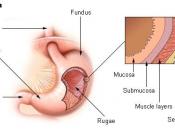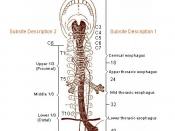-The esophagus is in the digestive system.
-The esophagus is a muscular tube which carries food and liquids from the throat to the stomach for digestion after it has been chewed and softened in the mouth.
-It is about 25 cm long and 2.5 cm across.
-Food is forced downward to the stomach by powerful wave like muscle contractions passing through the walls of the esophagus.
-The contractions are so strong in the throat and the esophagus, we can swallow in any position -- even upside-down!
-The esophagus wall contains two muscle layers, an inner circular layer and an outer circular layer.
-This contraction must be coordinated with a relaxation of the circular muscle and a contraction of the longitudinal muscle in front of the bolus.
-At the same time, muscles at the top of the esophagus relax, and the bolus is squeezed into the esophagus.
-A bolus is literally squeezed forward by a coordinated contraction of the circular muscle behind it.
-The muscular layers of the esophagus are pinched together at both ends by muscles called sphincters.
-When a person swallows, the sphincters relax automatically to allow food or drink to pass from the mouth and into the stomach.
-The muscles then closed rapidly to prevent the swallowed food or drink from leaking out of the stomach back into the esophagus or into the mouth.
-This is automatic and people are usually not aware of it.
Many people have felt their esophagus when they swallow something too large, try to eat too quickly, or drink very hot or very cold liquids.
-They then feel the movement of the food or drink down the esophagus into the stomach, which may be an uncomfortable feeling.
-Generally the esophagus is collapsed.
-It extends to a circular shape only when...


